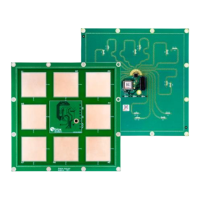XPLR-AOA-3 - User guide
UBX-22006906 - R07 EVB-ANT-1 Page 16 of 46
C1-Public
4.3 Main EVB-ANT-1 use cases
4.3.1 Anchor point
In this use case, the EVB-ANT-1 primarily supports ANT-B family antenna boards and routes direction
finding data to a position engine. For this purpose, the microcontroller must communicate with the
ANT-B family antenna board Bluetooth module using UART (or SPI) through the ANT-B family
connector. Direction finding data is then forwarded through the chosen communication interface –
either Ethernet or Wi-Fi using the MAYA-W1 module.
The highlighted areas in Figure 14 show the EVB-ANT-1 components involved in this use case.
Figure 14: EVB-ANT-1 components involved in the anchor point use case
4.3.2 Custom antenna support
EVB-ANT-1 also supports custom antenna boards that contain an antenna array and an RF switch.
To support the use case, an onboard NINA-B411 Bluetooth module can connect to a custom antenna
board through a 2.54 mm pitch connector. The module includes the power, the RF switch control
signals, and the U.FL connector for the RF signals. The MCU connects to the onboard NINA-B411
through the UART or SPI (pending software support), and GPIOs. Direction finding data can be
communicated to a host through the chosen communication interface – either Ethernet or Wi-Fi using
the MAYA-W1 module.

